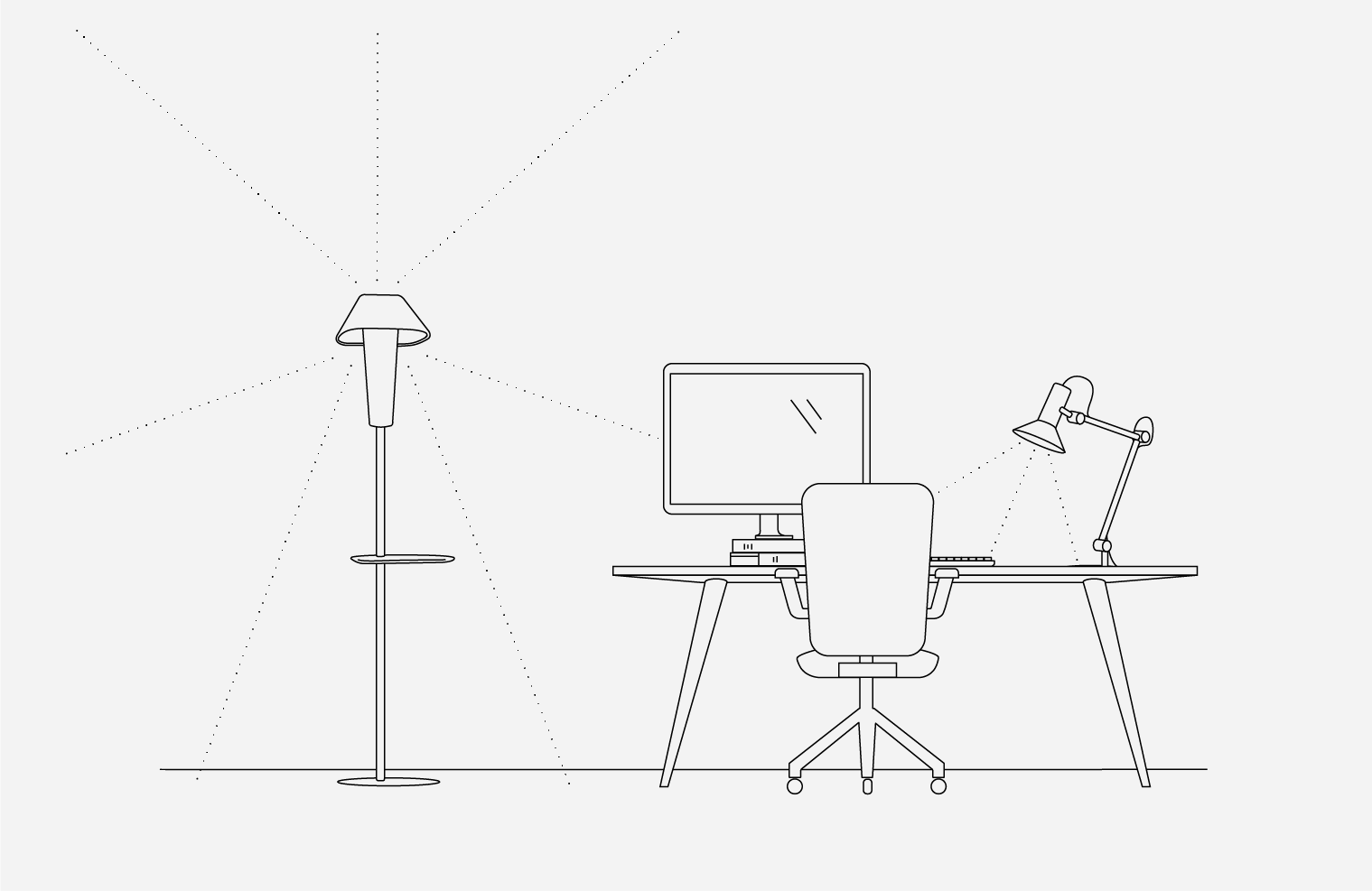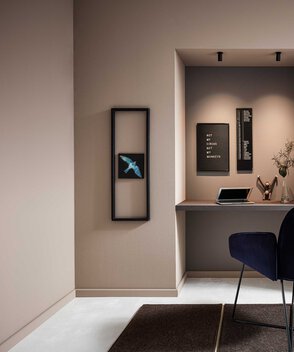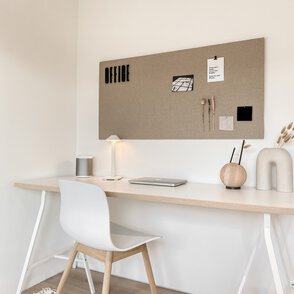Pyjamas all day long
The cat made herself comfortable on your keyboard again? Take it with humour. After all, your home office seems to have a pretty relaxed atmosphere. It's ideal for productive, deep work. How can it be made even cosier? Turn your home office into your very own personal retreat in just a few simple steps using a mix of direct and indirect lighting. A combination of floor, ceiling, and desk lights are ideal. They craft a stress-free ambience and fantastic working light.
Five tips for your home office Lighting
How to turn your home office into a personal retreat
Not so direct, please.
The most important rule in the home office is to always pay attention to homogeneous and glare-free background lighting. Varying light sources often leads to strong shadows and contrasts.
In the right light
Of course, you can expect a little more light in the workplace than at a candlelight dinner. The optimal working light is about 500 lux but could be somewhat lower, depending on the activity. Since we also want to feel comfortable at the workplace, warm mood lighting is just as important as good work lighting. Professional offices typically use 4000K. However, roughly 3000K is ideal in the home office.
Bet on teamwork
Nothing gets done without teamwork. Even in the home office. That's why it's best to work with different lights. Desk lights such as ROOMOR TABLE 1.1, are perfect for your desk. Indirect floor or suspended lights are ideal for ambient lighting.
Beautiful and practical
"Office lighting" sounds pretty sterile. But that needn’t be the case. Mixing decorative and functional luminaires can quickly set the mood, even for your home office lighting.
Let the sunshine in
The best place to work? Next to the window. Even the greatest home office lights don't hold a candle to natural light. We suggest you try to position your desk at an angle to the sunlight.
Lunch? Give me a second.
From presentation to pasta in record time.
If you turn your dining table into a desk, you have a clear advantage – it takes just a second to go from a meeting to lunch. Sounds like the perfect place to work. But don't just listen to your gut; see it with your own eyes. Your eyes can, with bad illumination, react sensitively very quickly. We recommend LED luminaires with Colour Warm Dimming. They continuously adjust their light intensity and colour temperature to your needs. Ideal for working at the dining table? 3000K or so keeps us awake during the day while boosting concentration. A quick twist in the evening switches to romantic candlelight. Sounds great? Then choose your favourite light, grab a phase-cut dimmer and get started. Good news for everyone who likes to keep it simple – nearly all of our lights are ready for dimming. Sounds great? Then choose your favourite light, grab a phase-cut dimmer and get started.
Most important questions about lighting in home offices
Long, deep work can be exhausting. Especially for the eyes. Constantly switching from light to dark is a great recipe for a headache. We definitely don't need that in our home office. Strong light contrasts should therefore be avoided as far as possible. Setting the workstation in a bright room with good natural light and positioning the desk parallel to the window is a better solution. This effectively guarantees relaxed work. If you want, you can also paint your home office with light and welcoming tones to make it even more comfortable. A balanced mix of daylight and artificial lighting, consisting of direct and indirect light sources is ideal.
The perfect colleagues in your home office? Ceiling lights. They deliver homogeneous study room lighting while creating a super-relaxed working atmosphere. The desk itself is best outfitted with a swivelling desk light, whose height and angle can be set at will. It is important never to use desk lights as the sole light source. Always combine them with indirect light. Decorative free-standing floor lights such as DRO FLOOR 3.0 quickly set the mood even in small home office rooms and are clearly the best choice. Incidentally, these are also the perfect choice for anyone who doesn't want or can't have ceiling lights in their home office.

Light boosts productivity. This is because our inner clock is aligned with the light-dark rhythm of the day and makes us feel more awake in the morning hours than in the evening. This is thanks to serotonin and cortisol, hormones which provide the necessary energy boost during the day. Their counterpart, melatonin, makes us think more of a soft bed in the evening than of office work. Depending on the activity, 300 to 500 lux are ideal at the workplace. It is important to remember that young people can usually manage with less light than older people whose eyesight is deteriorating. So if you need glasses, it's best to choose brighter lighting. But be careful. Too much light can quickly cause glare. We recommend a UGR value (unified glare rating) of <19 for home office lights.
We simply feel more comfortable in a bright and inviting environment. This applies to the home office every bit as much. The optimum light temperature is based on the natural course of the day. Evolution has perfectly adapted our biorhythm to this. This is why we feel much more active during the day, when the light temperature rises, than in the evening. Blue light is the secret behind this. The more blue light, the more productive we are. This is because bluish light activates the release of cortisol, which quickly revs up even the biggest office grump. In the evening, when the light temperature drops, it works the other way round. The hormone melatonin makes us tired and gets us to slowly wander towards the bedroom. What can we learn from this? Offices where the focus is on concentrated work are best equipped with 4000K luminaires. For cosy home offices that are also intended to be a private retreat, a colour of 3000K is entirely sufficient.
Having to say "I've been dazzled!" is best avoided in your home office. Reflective or dazzling elements are bad for our concentration and health. When positioning furniture and lights, always bear in mind the potential for irritation. Consider opting for lights that reduce glare, for example with lampshades or opal covers. How does glare come about in the first place? The most common culprit is areas of high light density that occur directly in our workplace's field of vision. However, if the environment is dimly lit, this affects our visual performance and mood. We feel stressed and tired more quickly as a result. Glare caused by the sun or incorrectly positioned lights is referred to as "direct glare". So-called "reflected glare" occurs when light strikes a table or a smooth, reflective surface such as a computer screen. Both should be avoided at all costs in the home office.























